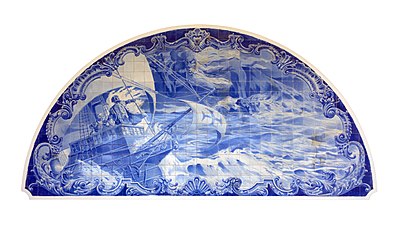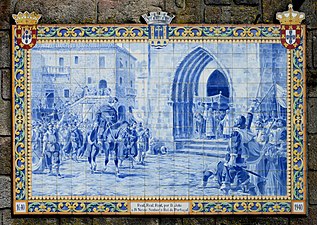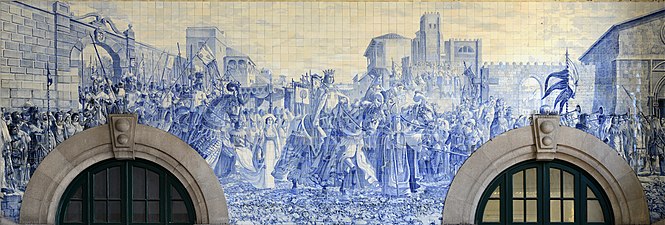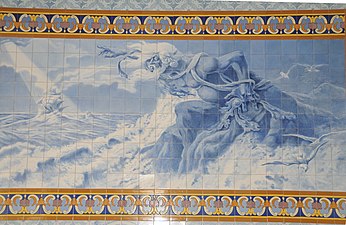Jorge Colaço
Jorge Colaço | |
|---|---|
 Jorge Colaço, c. 1908 | |
| Born | 26 February 1868 |
| Died | 23 August 1942 (aged 74) |
| Nationality | Portuguese |
| Known for | Painting |
| Notable work | |
| Movement | Romanticism |
Jorge Colaço (26 February 1868 - 23 August 1942) was a Portuguese painter specially known for his works as tile (azulejo) painter.
Jorge Colaço was born in Tangier, Morocco, the son of a Portuguese diplomat.[1] He studied art in Lisbon, Madrid and Paris.
Even though Jorge Colaço was a canvas painter and caricaturist, he specialised in designing and painting azulejo panels to decorate large surfaces. His designs had a late Romantic taste, celebrating the achievements of Portuguese history. Along with historical themes, he also produced ethnographic and landscape scenes.[2]
Among his most important works are tile panels in the Palace Hotel of Bussaco (1907); São Bento railway station in Porto (1905–1916); Sports Pavilion of Eduardo VII Park in Lisbon (1922); façade of the Church of Saint Ildefonso in Porto (1932) and many others. He also has works in Brazil, England (Windsor Castle), Geneva (Centre William Rappard[3]) and other countries.
Gallery
-
Tile panel (1922) in the Eduardo VII Park in Lisbon.
-
"Working on the Beach", at National Museum of the Azulejo.
-
"Popular Revolt, 1637" at Évora Train Station.
-
Tile panel at Vasco da Gama stadium in Rio de Janeiro.
-
"The Death of The Lidador" (1940) in the Beja Public Park, Beja, Portugal.
-
"They're Goats, Sire", monument in Ponte de Lima, Portugal.
-
Representing the acclamation of King John IV of Portugal, in 1640, Ponte de Lima, Portugal 1940.
-
Egas Moniz and his Family Before King Alfonso VII of Leon, 1903, at the São Bento Train Station in Porto.
-
Arrival of the Caique Bom Sucesso in Brazil.
-
Manuelinho revolt- azulejo by Jorge Colaço at Évora railway station
-
Revolt against the French, public monument in Olhão.
-
Conquest of Ceuta
-
"Afonso de Albuequerque in the Taking of Hormuz", 1933, Centro Cultural Rodrigues de Faria, Forjães.
-
The entry of King João I of Portugal in Porto, after his marriage with Philippa of Lancaster.
-
Azulejos depicting the Adamastor, in Centro Cultural Rodrigues de Faria, Forjães, Esposende, Portugal, from Jorge Colaço
-
"Nuno Álvares Pereira at the Battle of Aljubarrota", in Centro Cultural Rodrigues de Faria, Forjães
-
"Velada Hidroelectric Station" at the Vale do Peso Train Station.
-
"Foz Station" at the Vale do Peso Train Station
-
"Calvário, Nisa" at the Vale do Peso Train Station
-
"Ceramics, Nisa" at the Vale do Peso Train Station
-
"18th century Fountain" at the Vale do Peso Train Station
-
Adamastor, at Palace Hotel Bussaco.
-
Decorative tile panel at Bussaco Palace Hotel.
-
Decorative tile panel at Bussaco Palace Hotel.
-
Tile panel at Santo Ildefonso church in Portugal.
-
"Southern Cross" at Edward VII Park in Lisbon.
References
- ^ Camões Institute: review of Os Colaço, uma família portuguesa em Tânger by Jorge Forjaz [1] Archived 2005-02-09 at the Wayback Machine
- ^ "Camões Institute: History of the Azulejo in Portugal". Archived from the original on 2008-09-26. Retrieved 2008-08-01.
- ^ WTO Building; Centre William Rappard


























